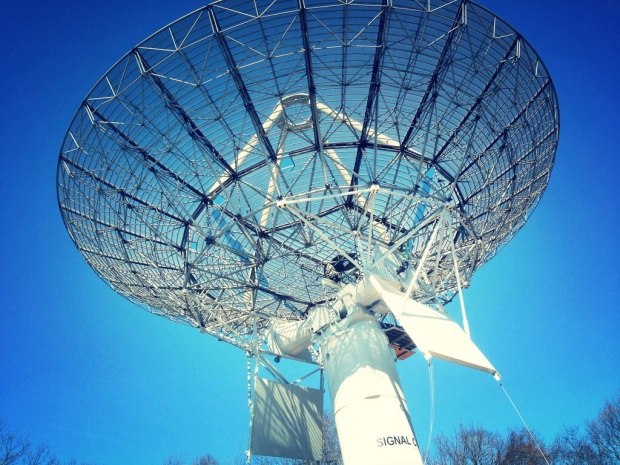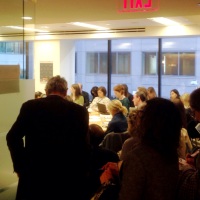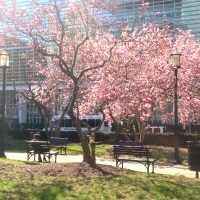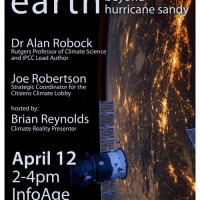Observing Earth: CCL at InfoAge on April 12
For Immediate Release: March 18, 2014
Observing Earth: Beyond Hurricane Sandy
Saturday, April 12, 2014, 2:00-4:00 pm
InfoAge Science History Museum
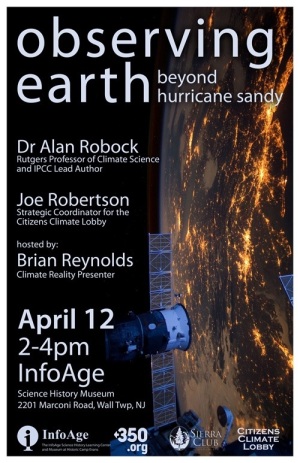 Wall Township, NJ — ‘Observing Earth: Beyond Hurricane Sandy’ is an Earth Month event to update the public on Earth’s changing climate, with a focus on risks and solutions. The event will be held Saturday, April 12, 2014, from 2:00-4:00 pm at the InfoAge Science History Museum in Wall Township, NJ. Last year’s ‘Earth Day Gathering’ event was attended by more than 80 people.
Wall Township, NJ — ‘Observing Earth: Beyond Hurricane Sandy’ is an Earth Month event to update the public on Earth’s changing climate, with a focus on risks and solutions. The event will be held Saturday, April 12, 2014, from 2:00-4:00 pm at the InfoAge Science History Museum in Wall Township, NJ. Last year’s ‘Earth Day Gathering’ event was attended by more than 80 people.
This year’s lineup will include Dr. Alan Robock, Professor II in the Department of Environmental Sciences at Rutgers University and the lead author of IPCC; Joseph Robertson, Strategic Coordinator for Citizens Climate Lobby and author of the book Building a Green Economy; and Brian Reynolds (host and moderator), who is a 350.org member and certified Climate Reality Project presenter.
The event will discuss several topics related to climate change, with some new perspectives. Dr. Robock will discuss the parallel dangers of nuclear conflict and climate change in a talk titled “Climatic Consequences of Nuclear Conflict: Nuclear Winter Still a Threat”.
Joe Robertson will deliver a presentation titled: “Living the Paradigm Shift: Inventing our Climate Future”, addressing the current state of the climate crisis along with technological and political solutions. Joe says “Human beings—with our industry, our technology and our numbers—are enough of a force to affect the integrity of the interlocking web of life supports that makes the Earth friendly to human life. We have real options available to allow us to manage that responsibility intelligently, for the benefit of future humanity; why would we not do that?”
The title ‘Observing Earth’ makes reference to the extraordinary history of scientific achievement at the InfoAge site. In 1960, Camp Evans was ground station for TIROS-I, the world’s first successful Earth-observing weather satellite, allowing for the first time a live feed of images of the Earth from space. That breakthrough in science, engineering and global information gathering, was a major success for NASA only two years after the agency formed, so successful that it expanded to create the vital Earth-observing work of the National Oceanic and Atmospheric Administration (NOAA).
Today, the Camp Evans National Historic Landmark exists as part of a science history museum called InfoAge. Fred Carl, InfoAge Director, admits most people are not aware of the historical impact the site had on modern society. “Advanced warning of an approaching hurricane gives time for people to flee to safety. Millions of lives have been spared thanks to the technology that was developed here” says Carl.
Saving lives is something the event organizer, Stephen Fowler, says is at the heart of the event. “It is from the vantage point of space that scientists are able to gather data that impacts us all. Whether it is a massive hurricane, man-made CO2 contributing to a greenhouse effect or information for a climate model study on the impact a nuclear blast has on the stratosphere, Earth observing satellites save lives by predicting our climate future.”
The historic TIROS radio dish and a 1940s Dymaxion Deployment Unit designed by green architecture pioneer Buckminster Fuller will be open from 1:00-5:00 pm on Saturday. Efforts are currently underway to restore the historic artifacts and optional guided tours will be offered at the conclusion of the program at 4:00 pm.
There will be a Tesla Model S at the entrance, for attendees who wish to see one of the already-existing cutting-edge solutions to the world’s climate-energy imbalance. (In May 2013, Consumer Reports gave the Tesla Model S the highest rating of any car ever tested.)
Local New Jersey chapters of 350.org, Citizens Climate Lobby, the Sierra Club and Monmouth Transitions are co-sponsoring the event.
There is a suggested donation of $5 per person. All proceeds go to supporting the museum.
– – –
Sources and Additional Information
- TIROS (Television and InfraRed Observation Satellite)
- NOAA: TIROS Overview
- NASA: 50 Years of Weather Watching from Space
In 1967, the astronaut Rusty Schweickart found himself temporarily cut off from radio communications while on a 47-minute spacewalk. He found himself looking, from a distance, at the planet he called home, and found himself driven to a unique perspective, without precedent in human history. Of his experience, Schweickart said: “[The Earth] is so small and so fragile and such a precious little spot in that universe that you can block it out with your thumb. And you realize that on that small spot, that little blue-and-white-thing, is everything that means anything to you — all of history and music and poetry and art and death and birth and love.”
Schweickart said he felt he had been put in that situation to be “the sensing element” for the entire human species, to understand a fundamental reality about the structure of the universe in an entirely new way. Earth-observing satellites carry on that work, matter-of-factly feeding us information with which to better understand our world, and our situation in it.
NOAA was created in 1970 by Pres. Nixon, “… for better protection of life and property from natural hazards … for a better understanding of the total environment … [and] for exploration and development leading to the intelligent use of our marine resources.” The technology that allowed for TIROS-I in 1960 also allowed for the WWI-era National Advisory Committee on Aeronautics (NACA) to become, in 1958, the global leader in space exploration we know as NASA, which only 11 years after it was formed successfully landed American astronauts on the Moon and returned them safely to Earth.
Presentation Summaries
Climatic Consequences of Nuclear Conflict: Nuclear Winter Still a Threat
by Dr. Alan Robock—Department of Environmental Sciences, Rutgers University, New Brunswick, NJ
robock(AT)envsci(DOT)rutgers(DOT)edu
A nuclear war between any two nuclear nations, with each country using 50 Hiroshima-sized atom bombs as airbursts on urban areas, would inject smoke from the resulting fires into the stratosphere. Climate model simulations find that the smoke would absorb sunlight, making it dark, cold, and dry at Earth’s surface and produce global-scale ozone depletion, with enhanced ultraviolet (UV) radiation. The climate change would be unprecedented in recorded human history, and crop models show that it would reduce agricultural production, with decreases of 10-40% in yield of winter wheat, rice, soybeans, and maize averaged over a decade. The impact of the nuclear war simulated here, using much less than 1% of the global nuclear arsenal, could sentence a billion people now living marginal existences to starvation.
The greatest nuclear threat still comes from the United States and Russia. Even the reduced arsenals that will remain in 2017 after the New START treaty, about 4000 between the U.S. and Russia, threaten the world with nuclear winter. The world as we know it could end any day as a result of an accidental nuclear war between the United States and Russia. With temperatures plunging below freezing, crops would die and massive starvation could kill most of humanity.
The continued environmental and resulting humanitarian impact of the use of even a small number of nuclear weapons must be considered in nuclear policy deliberations.
Living the Paradigm Shift: Inventing our Climate Future
by Joseph Robertson—Citizens Climate Lobby, Strategic Coordinator
jr(AT)citizensclimatelobby(DOT)org
The planet-wide natural process that builds resilient life-support mechanisms is made up of genuinely delicate systems, life-forms and collaborative relationships. Though it seems too vast and powerful to be directly affected by human behavior, our own industrial activity is so complex and far-reaching as to disrupt those delicate systems at the most intimate levels.
Everything we do that can be called “economic activity” rests on a solid foundation of these delicate natural systems, life-forms and collaborative relationships. And the word to describe how those life-support mechanisms come together, and how energy moves through and around them, is “climate”. We are, in our mainstream culture, only now beginning to talk more effectively about the ecological weight of climate-destabilizing activities.
As we begin to quantify the value of natural life-support systems, and the disruptions they face, we need to understand what kind of paradigm-shift solution can be deployed to rescue us from our own scientific, economic and political failings. This talk will give a clear illustration of how we can do that, and why no ideology need keep to the margins or work against the right corrective policy.
And, it will tell the inspiring story of how real political will is being built for the most important reform policy of our times, through the efforts of ordinary citizens, serving honorably in the role of citizen. We can invent our climate future; in fact, we already are. What we do now will determine how future generations experience the interplay of life-support mechanisms on this planet.
We are living the paradigm shift now; we can make it one that works for us, if we work together.
